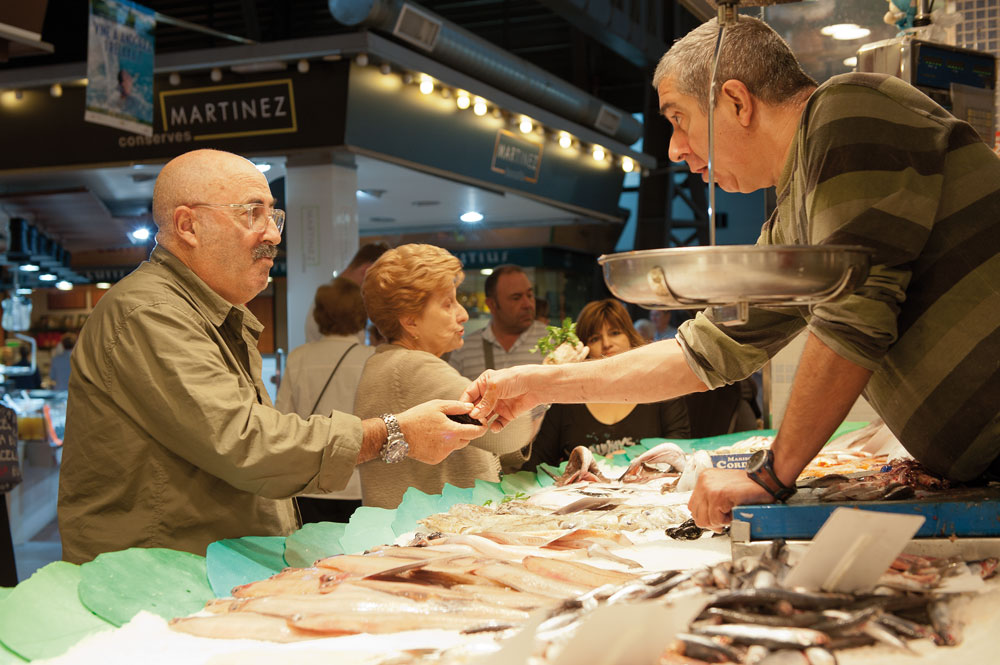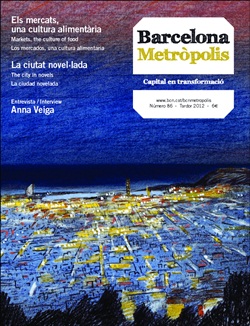Fresh products are the main asset of Barcelona’s markets, which jointly are the city’s leading company in the fresh food industry, having a market share of 30-35%, that increases to 70% in the case of fish.

© Albert Armengol
Toni Pamus, a retired fisher, shopping at the fish stall Encarna i Robert in the Barceloneta Market
Markets have existed as long as cities have. Moreover, in many places there is now a city where there was once a market. Even now, when we go shopping in the market we say we are going to the “plaça”, which in Catalan also means town square.
Our markets come from the 19th century. The Sarrià, Galvany and Sants markets were built at the beginning of the 20th century. In the 1950s and 60s a third wave of markets emerged. In the 80s, with the advent of supermarkets and superstores, the municipal market collapsed and has had to be reinvented. Many stallholders had to shut up shop. Markets were empty.
In 1992, the Barcelona Municipal Institute of Markets was founded to combat the situation and save a market model. With the empty space left in the wake of the crisis, the Institute proposed the construction of underground car parks for easy access and the inclusion of supermarkets in the actual market premises. Initially, stallholders were strongly opposed to this, because it was tantamount to letting the enemy in, but the strategy, launched in the Sagrada Família market in 1993, yielded good results. Time has shown that the cliché which holds that everything is cheaper in supermarkets is not true. Market stallholders pay in cash and get better prices. Wholesalers, however, pay after 90 days and this is reflected in the cost. Markets now offer everything: fresh quality products and basic supermarket commodities. A “one stop shop”.
The Institute of Markets was established to defend a model of markets that was to offer a service with added values: the health involved in eating fresh produce and the social benefit of a personalised service, especially for elderly people living alone, for whom the market is a place for social interaction. Barcelona currently has 40 local markets, which are home to over 2,700 businesses and employ 7,000 people. The built area is equivalent to 20 blocks of the Eixample district with an annual turnover of EUR 1 billion. According to data provided by the Institute of Markets, it is one of the city’s best-rated services after libraries and the metro.
According to some studies, market proximity can even have an influence on our weight. The further away you live from a market, the greater the risk of obesity. In supermarkets, consumers are influenced by the week’s special offers and end up eating more and unhealthily. As Peter Singer and Jim Mason, authors of The Ethics of What We Eat. Why Our Food Choices Matter, hold, referring to Britain: “a single meal consisting of chicken from Thailand, runner beans from Zambia, carrots from Spain, snowpeas from Zimbabwe, and potatoes from Italy, could have travelled a total of 24,364 miles… [It will have] cost an ecological fortune in fossil fuels coming across the continent.”
Markets offer local and seasonal products. In the case of fruit and vegetables, there are farmers who explain the methods they use and guarantee that we take home peaches that have travelled a maximum distance of 50 kilometres. Fresh produce is therefore the main added value of Barcelona’s markets, which, overall, constitute the leading fresh food selling company. Barcelona’s markets currently have a 30% to 35% share of the fresh food market. If we consider only fresh fish then the share rises to 70%. And then there is something else, which is priceless. Fishmongers can recommend the fish that are best for us. “Food quality obviously counts, but I come because they take care of me”, says one client, while Joan Brunet, of Peix Fresc Brunet in the Galvany Market, debones some mullets for him. He removes the bones, because “if we don’t then they won’t buy fish from us”, says Joan.
In the Barceloneta market, “we sellers know about fish, because most of us are fishermen or are relatives of fishermen, and therefore when people buy fish here they are more demanding”, says one fisherman. “If you come to the stalls you realise that they know their stuff.”
Thus, the markets of Barcelona allow us to be locavores – a neologism that refers to a person who eats local produce. The locavore movement is gaining ground in the United States and propounds the need to consume only food grown within a 160?kilometre radius. The movement has gradually grown. North American universities have joined it. In the United Kingdom in 1997 there was only one farmers’ market; by 2002 there were 450, 70% of which rated themselves as prosperous.
Markets are also a pole of economic life. The current model promotes strengthening the local economy and the area’s farmers. It also protects the environment and comes with the guarantee of local and seasonal food that has not been processed or been through any freezing, drying or canning process. People live markets as an experience; they have their breakfast or lunch there. Josep M. Coll, coordinator of the Unió de Pagesos [Farmers’ Union] of Camp de Tarragona, is a regular at the Bar Joan in the Santa Caterina Market. “Market bars offer excellent value for money, but what’s more, I can even buy fresh food at a stall and take it to the bar and have them cook it for me”, says Coll.
The bars in Barcelona’s markets are in tune with the stalls’ ideology. They cook food over a low heat and allow the dish to simmer. “Today there is cod, grilled swordfish, tripe, pigs’ trotters, sausage, meatballs, black rice, paella and omelettes.” These are the dishes that Joan Hernández, of Bar Joan, calls out one after another at 9 am every day while stall owners, workers from nearby building sites and clerical workers gulp them down sitting at the bar counter or the tables.
“The bars in Barcelona’s markets are in tune with the stalls’ ideology. They cook food over a low heat and allow the dish to simmer”
At El Rebost Bar, in the Galvany market, amid meatballs and omelettes, one customer says he likes the market because it is imposing – “my son says it is like a church” – with high ceilings, modernist stained glass windows, and domes. The red brick facade and imposing iron structure distinguish it from religious temples, but there is some truth in it, as markets always fill the soul. And the belly.



